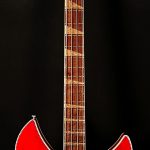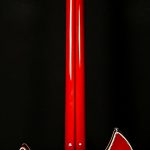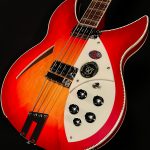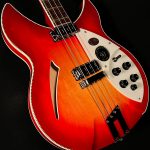Rickenbacker 90th Anniversary 4005XC
Rickenbackers are a part of America’s musical DNA. The low-end growl of their basses, the sparkle and bite of their six-strings, and the sweet chime of their twelve-strings have inspired everyone from Lemmy Kilmister to Tom Petty to Paul McCartney to Johnny Marr, and their unmistakable sound has formed the backbone of countless classic recordings. But, there’s much more to the story of Rickenbacker than chime and jangle; in fact, their penchant for innovation goes all the way back to the 1920s when they built the first electric guitar.
Back in the 1920s, lap steel guitar players were on a never-ending quest for more volume. One enterprising player named John Beauchamp contacted a violin repairman named John Dopyera about building him a louder instrument. Dopyera had a brilliant brainwave: why not put small resonator cones in the body of a metal guitar? They gave the prototype to the Sol Hoopii Trio (one of the most popular Hawaiian music groups of the time) and arranged for them to be the entertainment at a swanky party thrown by Beauchamp’s wealthy cousin-in-law, Ted Kleinmeyer. Kleinmeyer loved the sound of Dopyera’s resonator, and he wrote a check for startup capital that night. Thus, National Guitars was born.
The trio enlisted the help of a local production engineer named Adolph Rickenbacker set to work making guitars. Unfortunately, by 1929, the company had splintered due to personal differences. Dopyera left to found Dobro, and Beauchamp was in the unemployment line. He’d make National regret firing him, however. All he’d do with his suddenly-clear schedule was develop the first electric guitar pickup.
After months of winding prototype pickups using a repurposed washing machine motor and a sewing machine, Beauchamp finally arrived at a final design with two horseshoe magnets and six polepieces--one for each string. With his design finished, Beauchamp had Harry Watson, National’s former factory superintendent, build him a wooden body in a few hours using simple hand tools. Their final product--dubbed “The Frying Pan”--didn’t look too pretty, but it was a six-string milestone: the first electric guitar.
Beauchamp brought his old buddy Adolph Rickenbacker in to assist with product development and manufacturing, and together the two of them designed and built some of the finest lap steels the world has ever seen. They chose to brand them as Rickenbackers because Adolph’s cousin, World War I ace Eddie Rickenbacker, had made the name famous, and it was easier to say than “Beauchamp.” They expanded their line to include electric Spanish guitars and amplifiers, and they seemed poised to corner the growing market on electric instruments.
Their partnership would continue until 1940, when Beauchamp decided he’d prefer to live the good life and go fishing every day. Adolph continued to run the company until 1953 when he retired and sold the company to the man who made Rickenbacker what it is today: Francis C. Hall.
At the time, F.C. Hall was a distributor for K & F, Leo Fender’s first company, but he wanted more control over the product. He saw that electric six-strings, not lap steels, were the future of music, and he wanted to get in on the ground floor. Under his leadership, Rickenbacker expanded its line of solid- and hollow-bodied guitars, and they grew steadily until a small indie rock band from Britain called the Beatles broke big in the states. Every Beatle except Ringo played and loved Rickenbackers for most of their career, and this gave Rickenbacker unprecedented visibility. Beatlemania caused Rick Mania, and sales surged through the roof.
Thus began the era of Rickenbacker’s dominance over the airwaves. You couldn’t listen to the radio for more than ten minutes without hearing a tune that prominently featured a Rickenbacker, and their unmistakable sound became ingrained in the consciousness of anybody who loved pop music.
Years have gone by, and Rickenbacker’s models have evolved slightly, but not much has changed. They still build their instruments the same way they always have, and you can hear their unmistakable sound on (and this is a highly-scientific figure) approximately one zillion recordings. More importantly, they still have the same signature tone that makes heartstrings resonate.
We’re proud to present our selection of Rickenbackers, and we know their timeless tone will inspire you to reach new heights on your fretboard journey.
Specifications:
| Brand | Rickenbacker |
|---|
| Model | 4005XC |
|---|---|
| Finish Color | Amber Fireglo |
| Weight | 8.90 lbs. |
| Body Wood | Semi-Hollow Maple |
| Neck Wood | Maple |
| Neck Dimensions | .920 1st - .940 12th |
| Inlays | Crushed Pearl Triangles |
| Scale Length | 30.5" |
| Width at Nut | 1 11/16" |
| Frets | 24 |
| Binding | Checkerboard |
| Pickups | 2 Vintage-Style |
| Hardware | Chrome |
| Bridge | Schaller |
| Case | Rickenbacker Hardshell |
Why Order from Wildwood Guitars?
An instrument from Wildwood isn't just an ordinary guitar. It's your guitar. Each and every instrument we sell includes a full, point by point setup, an exhaustive evaluation, and expert shipping procedures, with first class, industry leading standards from start to finish. Why? Because you deserve it.Click Here to learn more about what makes a Wildwood instrument so special...








